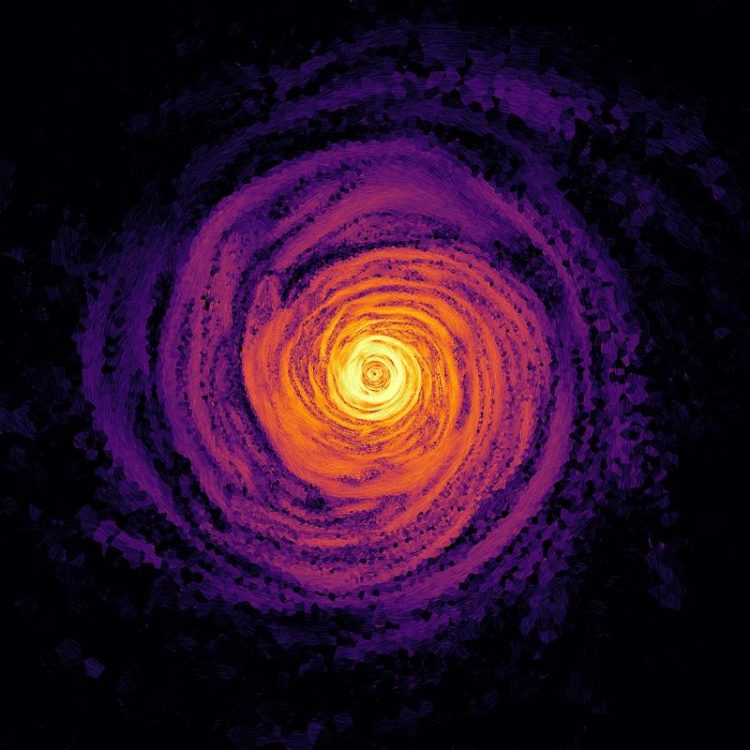How Do the Strongest Magnets in the Universe Form?

How Do the Strongest Magnets in the Universe Form?
German-British research team simulates basic conditions for the formation of magnetic stars
How do some neutron stars become the strongest magnets in the Universe? A German-British team of astrophysicists has found a possible answer to the question of how these so-called magnetars form.
The researchers used large computer simulations to demonstrate how the merger of two stars creates strong magnetic fields. If such stars explode in supernovae, magnetars could result. Scientists from Heidelberg University, the Max Planck Society, the Heidelberg Institute for Theoretical Studies, and the University of Oxford were involved in the research. The results were published in “Nature”.
Our Universe is threaded by magnetic fields. The Sun, for example, has an envelope in which convection continuously generates magnetic fields. “Even though massive stars have no such envelopes, we still observe a strong, large-scale magnetic field at the surface of about ten percent of them,” explains Dr Fabian Schneider from the Centre for Astronomy of Heidelberg University, who is the first author of the study in “Nature”. Although such fields were already discovered in 1947, their origin has remained elusive so far.
Over a decade ago, scientists suggested that strong magnetic fields are produced when two stars collide. “But until now, we weren’t able to test this hypothesis because we didn’t have the necessary computational tools,” says Dr Sebastian Ohlmann from the computing centre of the Max Planck Society in Garching near Munich.
This time, the researchers used the AREPO code, a highly dynamic simulation code running on compute clusters of the Heidelberg Institute for Theoretical Studies (HITS), to explain the properties of Tau Scorpii (τ Sco), a magnetic star located 500 light years from Earth.
Already in 2016, Fabian Schneider and Philipp Podsiadlowski from the University of Oxford realised that τ Sco is a so-called blue straggler. Blue stragglers are the product of merged stars. “We assume that Tau Scorpii obtained its strong magnetic field during the merger process,” explains Prof. Dr Philipp Podsiadlowski. Through its computer simulations of τ Sco, the German-British research team has now demonstrated that strong turbulence during the merger of two stars can create such a field.
Stellar mergers are relatively frequent: Scientists assume that about ten percent of all massive stars in the Milky Way are the products of such processes. This is in good agreement with the occurrence rate of magnetic massive stars, according to Dr Schneider. Astronomers think that these very stars could form magnetars when they explode in supernovae.
This may also happen to τ Sco when it explodes at the end of its life. The computer simulations suggest that the magnetic field generated would be sufficient to explain the exceptionally strong magnetic fields in magnetars. “Magnetars are thought to have the strongest magnetic fields in the Universe – up to one hundred million times stronger than the strongest magnetic field ever produced by humans,” says Friedrich Röpke from HITS.
The research was funded by the Oxford Hintze Centre for Astrophysical Surveys and the Klaus Tschira Foundation (Heidelberg).
Caption for Simulation_1.jpg and Simulation_2.jpg
The simulation marks the birth of a magnetic star such as Tau Scorpii. The image is a cut through the orbital plane where the colouring indicates the strength of the magnetic field and the light hatching reflects the direction of the magnetic field line.
Images: Ohlmann/Schneider/Röpke
Contact:
Heidelberg University
Communications and Marketing
Press Office, phone +49 6221 54-2311
presse@rektorat.uni-heidelberg.de
Dr Fabian Schneider
Centre for Astronomy of Heidelberg University (ZAH)
Institute for Astronomical Computing
Phone +49 6221 54-1881 or +49 6221 533-388
fabian.schneider@uni-heidelberg.de
F.R.N. Schneider, S.T. Ohlmann, P. Podsiadlowski, F.K. Röpke, S.A. Balbus, R. Pakmor, V. Springel: Stellar mergers as the origin of magnetic massive stars. Nature, doi: 10.1038/s41586-019-1621-5
Media Contact
More Information:
http://www.uni-heidelberg.deAll latest news from the category: Physics and Astronomy
This area deals with the fundamental laws and building blocks of nature and how they interact, the properties and the behavior of matter, and research into space and time and their structures.
innovations-report provides in-depth reports and articles on subjects such as astrophysics, laser technologies, nuclear, quantum, particle and solid-state physics, nanotechnologies, planetary research and findings (Mars, Venus) and developments related to the Hubble Telescope.
Newest articles

NASA: Mystery of life’s handedness deepens
The mystery of why life uses molecules with specific orientations has deepened with a NASA-funded discovery that RNA — a key molecule thought to have potentially held the instructions for…

What are the effects of historic lithium mining on water quality?
Study reveals low levels of common contaminants but high levels of other elements in waters associated with an abandoned lithium mine. Lithium ore and mining waste from a historic lithium…

Quantum-inspired design boosts efficiency of heat-to-electricity conversion
Rice engineers take unconventional route to improving thermophotovoltaic systems. Researchers at Rice University have found a new way to improve a key element of thermophotovoltaic (TPV) systems, which convert heat…



